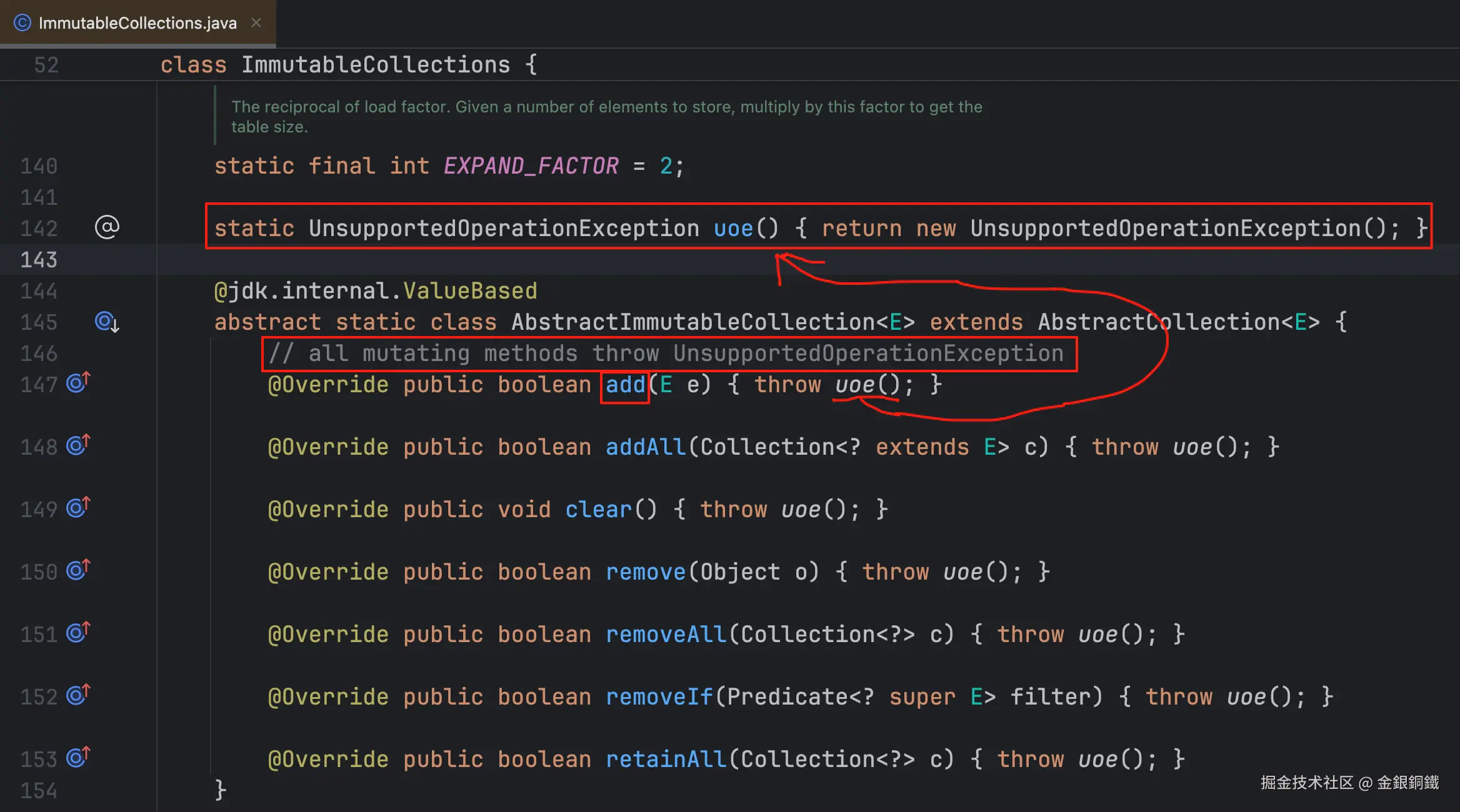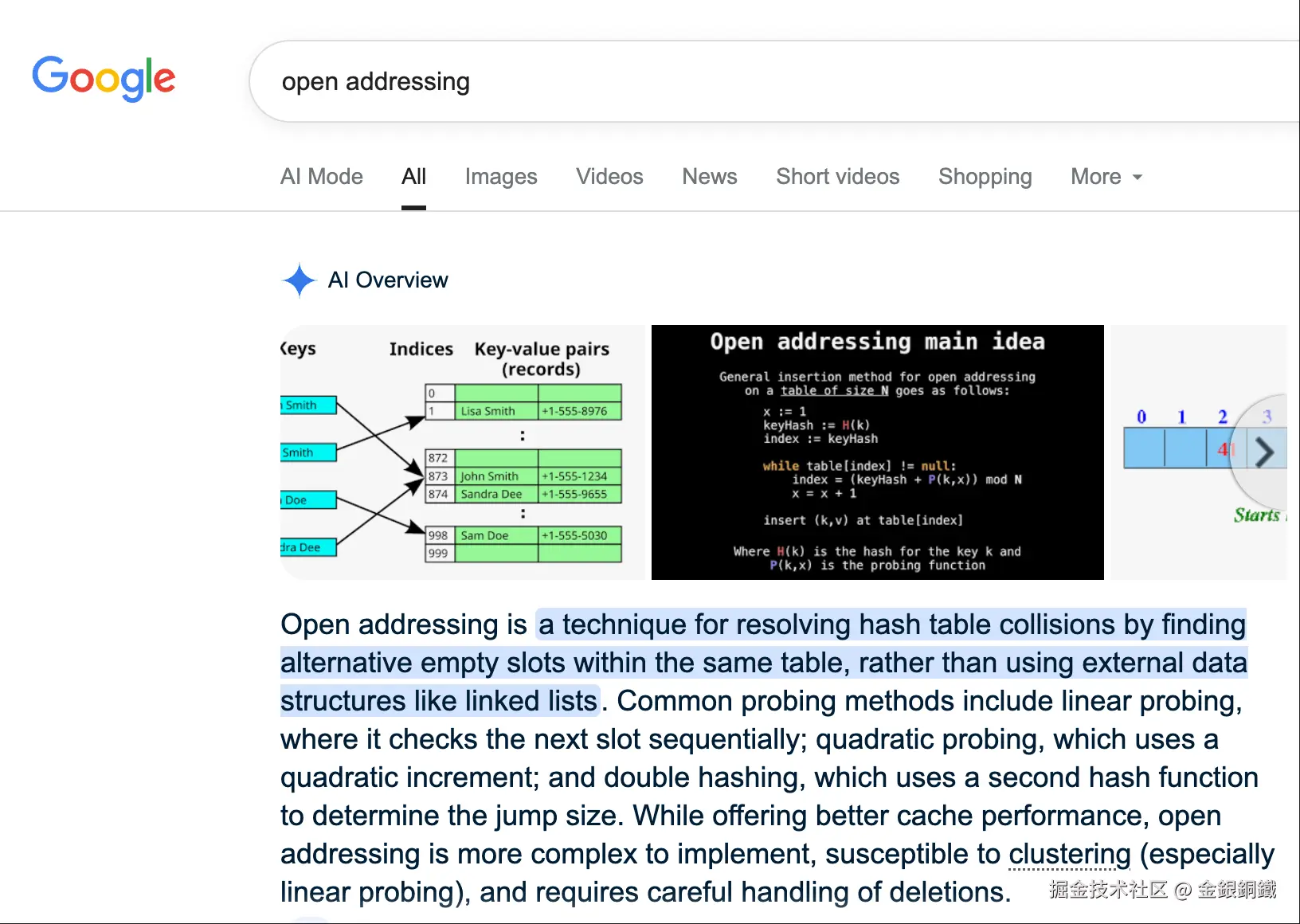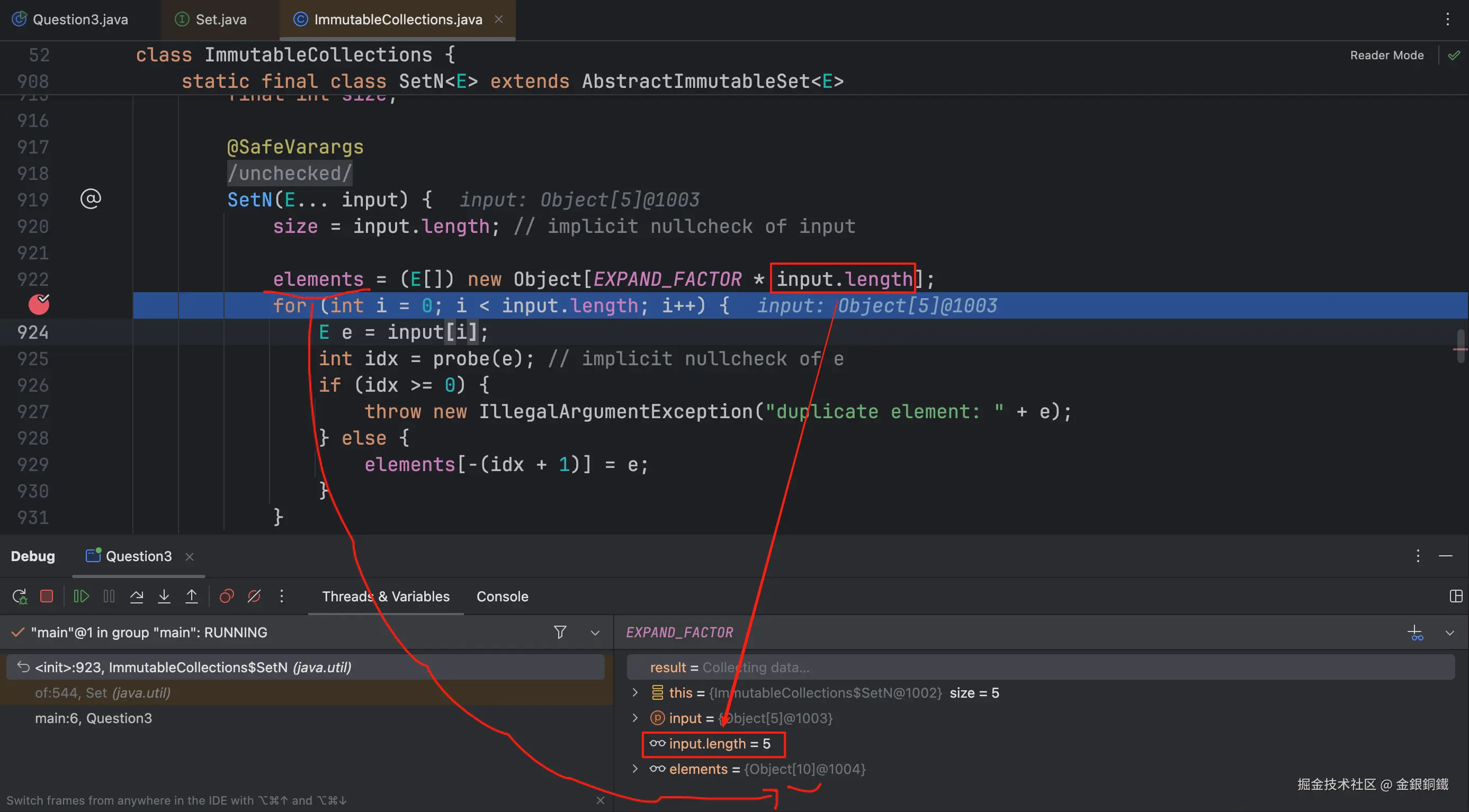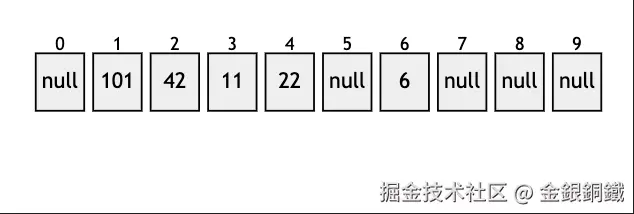浅析 java 中的 Set.of(...) 方法
JDK 9 在 java.util.Set 接口中提供了一组 of(...) 静态方法(代码可参考 Set.java)。通过调用这些静态方法,我们可以构造不可变(immutable)集合。
这组方法涵盖了以下 <math xmlns="http://www.w3.org/1998/Math/MathML"> 2 2 </math>2 类情形 ⬇️
-
逐个提供元素作为参数:参数个数 <math xmlns="http://www.w3.org/1998/Math/MathML"> n n </math>n 从 <math xmlns="http://www.w3.org/1998/Math/MathML"> 0 0 </math>0 到 <math xmlns="http://www.w3.org/1998/Math/MathML"> 10 10 </math>10 共有 <math xmlns="http://www.w3.org/1998/Math/MathML"> 11 11 </math>11 种情况(这里只列出了 <math xmlns="http://www.w3.org/1998/Math/MathML"> 0 ≤ n ≤ 3 0\le n \le3 </math>0≤n≤3 的情况, <math xmlns="http://www.w3.org/1998/Math/MathML"> n ≥ 4 n \ge 4 </math>n≥4 的情况是类似的)
of()of(E e1)of(E e1, E e2)of(E e1, E e2, E e3)
-
元素以数组方式提供
of(E... elements)
当您调用这些方法时,有没有想过以下问题? ⬇️
Set.of(...)返回的Set具体是什么类型的,是HashSet吗,还是其他类型的Set?- 为什么
Set.of(...)返回的Set具有不可变(immutable)的特点,它是如何实现的? Set.of(...)所返回的Set,是如何存储元素的?
本文会从以上 <math xmlns="http://www.w3.org/1998/Math/MathML"> 3 3 </math>3 个问题入手,对 Set.of(...) 方法进行探索。
要点
Set.of(...)所返回的Set的精确类型与待处理的 元素个数 <math xmlns="http://www.w3.org/1998/Math/MathML"> n n </math>n 有关- 如果 <math xmlns="http://www.w3.org/1998/Math/MathML"> n = 1 n=1 </math>n=1 或 <math xmlns="http://www.w3.org/1998/Math/MathML"> n = 2 n=2 </math>n=2,
Set的精确类型会是java.util.ImmutableCollections.Set12 - 如果 <math xmlns="http://www.w3.org/1998/Math/MathML"> n = 0 n=0 </math>n=0 或 <math xmlns="http://www.w3.org/1998/Math/MathML"> n ≥ 3 n \ge 3 </math>n≥3,
Set的精确类型会是java.util.ImmutableCollections.SetN
- 如果 <math xmlns="http://www.w3.org/1998/Math/MathML"> n = 1 n=1 </math>n=1 或 <math xmlns="http://www.w3.org/1998/Math/MathML"> n = 2 n=2 </math>n=2,
AbstractImmutableCollection中的add(...)/remove(...)等方法会抛出UnsupportedOperationException,而Set12和SetN都间接继承了AbstractImmutableCollection,所以Set12/SetN的实例就是不可变(immutable)的了SetN中有elements字段,它的length会是元素数量的2倍(元素个数总是 <math xmlns="http://www.w3.org/1998/Math/MathML"> > 0 \gt0 </math>>0)。在保存元素和查询元素时,会使用 开放寻址法(open addressing)
正文
问题一:Set.of(...) 返回的 Set 具体是什么类型的,是 HashSet 吗,还是其他类型的 Set?
我写了如下的代码来进行探索 ⬇️
java
import java.util.Set;
public class Question1 {
public static void main(String[] args) {
System.out.println(Set.of().getClass().getName());
System.out.println(Set.of(1).getClass().getName());
System.out.println(Set.of(1, 2).getClass().getName());
System.out.println(Set.of(1, 2, 3).getClass().getName());
}
}请将以上代码保存为 Question1.java,用如下的命令可以编译 Question1.java 并运行 Question1 类的 main 方法。
bash
javac Question1.java
java Question1运行结果如下
text
java.util.ImmutableCollections$SetN
java.util.ImmutableCollections$Set12
java.util.ImmutableCollections$Set12
java.util.ImmutableCollections$SetN看来 Set.of(...) 方法返回的值可以是以下两个类的实例 ⬇️
java.util.ImmutableCollections.Set12java.util.ImmutableCollections.SetN
但仅凭以上几行代码所列举的情况,并不能说明 Set.of(...) 的返回值是否有可能是其他类的实例,我们还是去看源码吧。 在 Set.java 中可以找到各个 Set.of(...) 方法的代码。这里有两种情形。
情形一:逐个提供元素作为 Set.of(...) 的参数
参数个数 <math xmlns="http://www.w3.org/1998/Math/MathML"> n n </math>n 从 <math xmlns="http://www.w3.org/1998/Math/MathML"> 0 0 </math>0 到 <math xmlns="http://www.w3.org/1998/Math/MathML"> 10 10 </math>10 共有 <math xmlns="http://www.w3.org/1998/Math/MathML"> 11 11 </math>11 种情况。其中 <math xmlns="http://www.w3.org/1998/Math/MathML"> n n </math>n 从 <math xmlns="http://www.w3.org/1998/Math/MathML"> 3 3 </math>3 到 <math xmlns="http://www.w3.org/1998/Math/MathML"> 10 10 </math>10 的情况代码高度雷同,我就不复制过来了,以下只展示 <math xmlns="http://www.w3.org/1998/Math/MathML"> n = 0 , 1 , 2 , 3 n=0, 1, 2, 3 </math>n=0,1,2,3 的情况 ⬇️ (为了节约空间,对应的 javadoc 都略去了)
java
@SuppressWarnings("unchecked")
static <E> Set<E> of() {
return (Set<E>) ImmutableCollections.EMPTY_SET;
}
static <E> Set<E> of(E e1) {
return new ImmutableCollections.Set12<>(e1);
}
static <E> Set<E> of(E e1, E e2) {
return new ImmutableCollections.Set12<>(e1, e2);
}
static <E> Set<E> of(E e1, E e2, E e3) {
return new ImmutableCollections.SetN<>(e1, e2, e3);
}可以将代码中的信息汇总成下方的表格 ⬇️
| 参数个数 <math xmlns="http://www.w3.org/1998/Math/MathML"> n n </math>n | Set.of(...) 返回什么 |
说明 |
|---|---|---|
| <math xmlns="http://www.w3.org/1998/Math/MathML"> n = 0 n=0 </math>n=0 | ImmutableCollections.EMPTY_SET |
⬅️ 它是 ImmutableCollections.SetN 类型的 |
| <math xmlns="http://www.w3.org/1998/Math/MathML"> n = 1 n=1 </math>n=1 | ImmutableCollections.Set12 的实例 |
|
| <math xmlns="http://www.w3.org/1998/Math/MathML"> n = 2 n=2 </math>n=2 | ImmutableCollections.Set12 的实例 |
|
| <math xmlns="http://www.w3.org/1998/Math/MathML"> 3 ≤ n ≤ 10 3\le n\le10 </math>3≤n≤10 | ImmutableCollections.SetN 的实例 |
<math xmlns="http://www.w3.org/1998/Math/MathML"> n = 0 n=0 </math>n=0 时,Set.of() 返回的也是 java.util.ImmutableCollections.SetN 的实例。可以把上方的表格再简化一下,变成下面这样 ⬇️
| 参数个数 <math xmlns="http://www.w3.org/1998/Math/MathML"> n n </math>n | Set.of(...) 返回什么 |
|---|---|
| <math xmlns="http://www.w3.org/1998/Math/MathML"> n = 1 n=1 </math>n=1 或 <math xmlns="http://www.w3.org/1998/Math/MathML"> n = 2 n=2 </math>n=2 | java.util.ImmutableCollections.Set12 的实例 |
| <math xmlns="http://www.w3.org/1998/Math/MathML"> n = 0 n=0 </math>n=0 或 <math xmlns="http://www.w3.org/1998/Math/MathML"> 3 ≤ n ≤ 10 3\le n\le10 </math>3≤n≤10 | java.util.ImmutableCollections.SetN 的实例 |
情形二:元素以数组方式提供
这次我们直接看源码 ⬇️
java
/**
* Returns an unmodifiable set containing an arbitrary number of elements.
* See <a href="#unmodifiable">Unmodifiable Sets</a> for details.
*
* @apiNote
* This method also accepts a single array as an argument. The element type of
* the resulting set will be the component type of the array, and the size of
* the set will be equal to the length of the array. To create a set with
* a single element that is an array, do the following:
*
* <pre>{@code
* String[] array = ... ;
* Set<String[]> list = Set.<String[]>of(array);
* }</pre>
*
* This will cause the {@link Set#of(Object) Set.of(E)} method
* to be invoked instead.
*
* @param <E> the {@code Set}'s element type
* @param elements the elements to be contained in the set
* @return a {@code Set} containing the specified elements
* @throws IllegalArgumentException if there are any duplicate elements
* @throws NullPointerException if an element is {@code null} or if the array is {@code null}
*
* @since 9
*/
@SafeVarargs
@SuppressWarnings("varargs")
static <E> Set<E> of(E... elements) {
switch (elements.length) { // implicit null check of elements
case 0:
@SuppressWarnings("unchecked")
var set = (Set<E>) ImmutableCollections.EMPTY_SET;
return set;
case 1:
return new ImmutableCollections.Set12<>(elements[0]);
case 2:
return new ImmutableCollections.Set12<>(elements[0], elements[1]);
default:
return new ImmutableCollections.SetN<>(elements);
}
}这个 switch 语句对元素个数的分类与 情形一 类似,我们可以把 情形二 的情况整理成如下表格 ⬇️
elements 参数的 length |
Set.of(E... elements) 返回什么 |
说明 |
|---|---|---|
| <math xmlns="http://www.w3.org/1998/Math/MathML"> l e n g t h = 0 length=0 </math>length=0 | ImmutableCollections.EMPTY_SET |
⬅️ 它是 ImmutableCollections.SetN 类型的 |
| <math xmlns="http://www.w3.org/1998/Math/MathML"> l e n g t h = 1 length=1 </math>length=1 | ImmutableCollections.Set12 的实例 |
|
| <math xmlns="http://www.w3.org/1998/Math/MathML"> l e n g t h = 2 length=2 </math>length=2 | ImmutableCollections.Set12 的实例 |
|
| <math xmlns="http://www.w3.org/1998/Math/MathML"> l e n g t h ≥ 3 length\ge 3 </math>length≥3 | ImmutableCollections.SetN 的实例 |
情形一和情形二的汇总
现在可以把情形一和情形二汇总成如下的表格 ⬇️
| 元素个数 <math xmlns="http://www.w3.org/1998/Math/MathML"> n n </math>n | Set.of(...) 返回什么 |
|---|---|
| <math xmlns="http://www.w3.org/1998/Math/MathML"> n = 1 n=1 </math>n=1 或 <math xmlns="http://www.w3.org/1998/Math/MathML"> n = 2 n=2 </math>n=2 | java.util.ImmutableCollections.Set12 的实例 |
| <math xmlns="http://www.w3.org/1998/Math/MathML"> n = 0 n=0 </math>n=0 或 <math xmlns="http://www.w3.org/1998/Math/MathML"> n ≥ 3 n\ge3 </math>n≥3 | java.util.ImmutableCollections.SetN 的实例 |
我给 Set12/SetN 画了张类图(图中把所有的泛型都省略了) ⬇️ 从类图中可以看到 Set12/SetN 实现了哪些接口。
小总结
Set.of(...) 所返回的 Set 的精确类型与待处理的元素 个数 <math xmlns="http://www.w3.org/1998/Math/MathML"> n n </math>n 有关
- 如果 <math xmlns="http://www.w3.org/1998/Math/MathML"> n = 1 n=1 </math>n=1 或 <math xmlns="http://www.w3.org/1998/Math/MathML"> n = 2 n=2 </math>n=2,
Set的精确类型会是java.util.ImmutableCollections.Set12 - 如果 <math xmlns="http://www.w3.org/1998/Math/MathML"> n = 0 n=0 </math>n=0 或 <math xmlns="http://www.w3.org/1998/Math/MathML"> n ≥ 3 n \ge 3 </math>n≥3,
Set的精确类型会是java.util.ImmutableCollections.SetN
问题二:为什么 Set.of(...) 返回的 Set 具有不可变(immutable)的特点,它是如何实现的?
我们可以写点代码来进行分析。 请将以下代码保存为 Question2.java。
java
import java.util.Set;
public class Question2 {
public static void main(String[] args) {
Set.of().add(1);
}
}如下的命令可以编译 Question2.java 以及运行 Question2 类中的 main 方法。
bash
javac Question2.java
java Question2运行上述命令后,会看到以下的报错
text
Exception in thread "main" java.lang.UnsupportedOperationException
at java.base/java.util.ImmutableCollections.uoe(ImmutableCollections.java:142)
at java.base/java.util.ImmutableCollections$AbstractImmutableCollection.add(ImmutableCollections.java:147)
at Question2.main(Question2.java:5)根据上述报错信息,可以找到抛出异常的位置如下 ⬇️
 图中 <math xmlns="http://www.w3.org/1998/Math/MathML"> 146 146 </math>146 行有如下注释 ⬇️
图中 <math xmlns="http://www.w3.org/1998/Math/MathML"> 146 146 </math>146 行有如下注释 ⬇️
// all mutating methods throw UnsupportedOperationException
从图中的代码也可以看出 addAll(...)/clear()/remove(...)/removeAll(...) 等方法都会抛出 UnsupportedOperationException
我画了张简单的类图来辅助理解 ⬇️ (图中将所有泛型信息都省略了,和 问题二 无关的接口/字段/方法·也略去了)
小总结
AbstractImmutableCollection 中的 add(...)/remove(...) 等方法会抛出 UnsupportedOperationException,而 Set12 和 SetN 都间接继承了 AbstractImmutableCollection,所以 Set12/SetN 的实例就是不可变(immutable)的了
问题三:其中的元素是如何存储的?
这里需要区分 Set12/SetN 两种情况
Set12
在 ImmutableCollections.java 中,可以找到 Set12 的代码,其中部分代码如下 ⬇️
java
@jdk.internal.ValueBased
static final class Set12<E> extends AbstractImmutableSet<E>
implements Serializable {
@Stable
private final E e0;
@Stable
private final Object e1;
Set12(E e0) {
this.e0 = Objects.requireNonNull(e0);
// Use EMPTY as a sentinel for an unused element: not using null
// enable constant folding optimizations over single-element sets
this.e1 = EMPTY;
}
Set12(E e0, E e1) {
if (e0.equals(Objects.requireNonNull(e1))) { // implicit nullcheck of e0
throw new IllegalArgumentException("duplicate element: " + e0);
}
this.e0 = e0;
this.e1 = e1;
}
@Override
public int size() {
return (e1 == EMPTY) ? 1 : 2;
}
@Override
public boolean isEmpty() {
return false;
}
@Override
public boolean contains(Object o) {
return o.equals(e0) || e1.equals(o); // implicit nullcheck of o
}
@Override
public int hashCode() {
return e0.hashCode() + (e1 == EMPTY ? 0 : e1.hashCode());
}字段
Set12 中有如下两个字段 ⬇️
private final E e0private final Object e1
构造函数
在调用 Set12(E e0) 这个构造函数时,
e0参数会被赋给e0字段e1字段会是一个特殊值(不是null)
在调用 Set12(E e0, E e1) 这个构造函数时,
e0参数会被赋给e0字段e1参数会被赋给e1字段
Set12 中的 size()/isEmpty() 等方法的逻辑也比较直观,这里就不赘述了。
小总结
Set12 可以处理集合中元素个数 <math xmlns="http://www.w3.org/1998/Math/MathML"> n n </math>n 是 <math xmlns="http://www.w3.org/1998/Math/MathML"> 1 1 </math>1 或 <math xmlns="http://www.w3.org/1998/Math/MathML"> 2 2 </math>2 的情况。
SetN
在 ImmutableCollections.java 中,可以找到 SetN 的代码,其中部分代码如下 ⬇️
java
/**
* An array-based Set implementation. The element array must be strictly
* larger than the size (the number of contained elements) so that at
* least one null is always present.
* @param <E> the element type
*/
@jdk.internal.ValueBased
static final class SetN<E> extends AbstractImmutableSet<E>
implements Serializable {
@Stable
final E[] elements;
@Stable
final int size;
@SafeVarargs
@SuppressWarnings("unchecked")
SetN(E... input) {
size = input.length; // implicit nullcheck of input
elements = (E[])new Object[EXPAND_FACTOR * input.length];
for (int i = 0; i < input.length; i++) {
E e = input[i];
int idx = probe(e); // implicit nullcheck of e
if (idx >= 0) {
throw new IllegalArgumentException("duplicate element: " + e);
} else {
elements[-(idx + 1)] = e;
}
}
}
@Override
public int size() {
return size;
}
@Override
public boolean isEmpty() {
return size == 0;
}在上面的代码中,可以看到 SetN 中的字段以及构造函数的逻辑。
字段
SetN 中有如下两个字段 ⬇️
final E[] elementsfinal int size
而这两个字段的作用是 ⬇️
- 在
SetN的构造函数中,会向elements字段填充元素(具体是如何填充的,我们等一下再说),所以elements字段应该是保存集合中的元素的地方。 size字段用于表示集合中的元素数量。
构造函数
我在构造函数的代码中加了点注释 ⬇️ (代码里原有的注释也没删除)
java
@SafeVarargs
@SuppressWarnings("unchecked")
SetN(E... input) {
// 获取元素个数
size = input.length; // implicit nullcheck of input
// EXPAND_FACTOR 值为 2,所以 elements 的长度会是 2 * size
elements = (E[])new Object[EXPAND_FACTOR * input.length];
// 遍历处理,为每一个元素找到它该去的地方
for (int i = 0; i < input.length; i++) {
E e = input[i];
// 利用开放寻址法(open addressing)找到 e 应该去的位置
int idx = probe(e); // implicit nullcheck of e
if (idx >= 0) {
throw new IllegalArgumentException("duplicate element: " + e);
} else {
// -(idx + 1) 就是 e 应该去的位置
elements[-(idx + 1)] = e;
}
}
}这里大部分逻辑都很直观,只有 int idx = probe(e); 这一行看起来不太好懂。 这里涉及 开放寻址法(open addressing) ⬇️

我按照自己的理解说一下它的思想 ⬇️ (这里只说保存元素和查询元素,不涉及 删除 元素)
用开放寻址法保存元素
我们在使用 hashCode 时,会遇到有冲突的情况。假设现在有一个 <math xmlns="http://www.w3.org/1998/Math/MathML"> l e n g t h = 10 length=10 </math>length=10 的数组 <math xmlns="http://www.w3.org/1998/Math/MathML"> A A </math>A,一开始数组 <math xmlns="http://www.w3.org/1998/Math/MathML"> A A </math>A 为空,我们想把如下的元素保存到数组 <math xmlns="http://www.w3.org/1998/Math/MathML"> A A </math>A 中。
E1(假设它的hashCode是 <math xmlns="http://www.w3.org/1998/Math/MathML"> 564132213 564132213 </math>564132213)E2(假设它的hashCode是 <math xmlns="http://www.w3.org/1998/Math/MathML"> 315343729 315343729 </math>315343729)E3(假设它的hashCode是 <math xmlns="http://www.w3.org/1998/Math/MathML"> 6323193 6323193 </math>6323193)
一个办法是利用 hashCode % 10 来计算每个元素应该保存到哪里去。 经过简单的计算,可以得到如下的表格 ⬇️
| 哪个元素 | hashCode |
hashCode % 10 |
|---|---|---|
E1 |
<math xmlns="http://www.w3.org/1998/Math/MathML"> 564132213 564132213 </math>564132213 | <math xmlns="http://www.w3.org/1998/Math/MathML"> 3 3 </math>3 |
E2 |
<math xmlns="http://www.w3.org/1998/Math/MathML"> 315343729 315343729 </math>315343729 | <math xmlns="http://www.w3.org/1998/Math/MathML"> 9 9 </math>9 |
E3 |
<math xmlns="http://www.w3.org/1998/Math/MathML"> 6323193 6323193 </math>6323193 | <math xmlns="http://www.w3.org/1998/Math/MathML"> 3 3 </math>3 |
最初数组 <math xmlns="http://www.w3.org/1998/Math/MathML"> A A </math>A 为空,其中是 <math xmlns="http://www.w3.org/1998/Math/MathML"> 10 10 </math>10 个 <math xmlns="http://www.w3.org/1998/Math/MathML"> n u l l null </math>null ⬇️  将
将 E1 保存到下标为 <math xmlns="http://www.w3.org/1998/Math/MathML"> 3 3 </math>3 的位置之后 ⬇️

将 E2 保存到下标为 <math xmlns="http://www.w3.org/1998/Math/MathML"> 9 9 </math>9 的位置之后 ⬇️

尝试将 E3 保存到下标为 <math xmlns="http://www.w3.org/1998/Math/MathML"> 3 3 </math>3 的位置时,会发现这个位置已经被占了(被 E1 占了),于是再尝试把 E3 保存到下一个位置去(如果现在已经是下标最大的位置,那就尝试把 E3 保存到下标为 <math xmlns="http://www.w3.org/1998/Math/MathML"> 0 0 </math>0 的位置)。下标为 <math xmlns="http://www.w3.org/1998/Math/MathML"> 4 4 </math>4 的位置尚未被占用,所以我们将 E3 保存到下标为 <math xmlns="http://www.w3.org/1998/Math/MathML"> 4 4 </math>4 的位置(如果下标为 <math xmlns="http://www.w3.org/1998/Math/MathML"> 4 4 </math>4 的位置也被占用了,那就继续检查下一个位置,直到找到空位置为止) ⬇️

注意,由于 E3 和 E1 要去的位置有冲突,所以最终 E3 保存在了下标为 <math xmlns="http://www.w3.org/1998/Math/MathML"> 4 4 </math>4 的位置 ⬇️
| 哪个元素 | hashCode |
hashCode % 10 |
实际保存在了哪里 |
|---|---|---|---|
E1 |
<math xmlns="http://www.w3.org/1998/Math/MathML"> 564132213 564132213 </math>564132213 | <math xmlns="http://www.w3.org/1998/Math/MathML"> 3 3 </math>3 | 下标为 <math xmlns="http://www.w3.org/1998/Math/MathML"> 3 3 </math>3 的位置 |
E2 |
<math xmlns="http://www.w3.org/1998/Math/MathML"> 315343729 315343729 </math>315343729 | <math xmlns="http://www.w3.org/1998/Math/MathML"> 9 9 </math>9 | 下标为 <math xmlns="http://www.w3.org/1998/Math/MathML"> 9 9 </math>9 的位置 |
E3 |
<math xmlns="http://www.w3.org/1998/Math/MathML"> 6323193 6323193 </math>6323193 | <math xmlns="http://www.w3.org/1998/Math/MathML"> 3 3 </math>3 | 下标为 <math xmlns="http://www.w3.org/1998/Math/MathML"> 4 4 </math>4 的位置 |
用开放寻址法查询元素是否存在
查询的过程也要用到 hashCode。下面举两个例子 ⬇️
- 我们现在要查询数组 <math xmlns="http://www.w3.org/1998/Math/MathML"> A A </math>A 中有
E2元素,E2的hashCode是 <math xmlns="http://www.w3.org/1998/Math/MathML"> 315343729 315343729 </math>315343729,hashCode % 10得到的结果是9,检查下标为9的位置,那里不是null而且保存的元素和E2相等,所以数组 <math xmlns="http://www.w3.org/1998/Math/MathML"> A A </math>A 中有E2元素。 - 我们现在要查询数组 <math xmlns="http://www.w3.org/1998/Math/MathML"> A A </math>A 中有
E3元素,E3的hashCode是 <math xmlns="http://www.w3.org/1998/Math/MathML"> 6323193 6323193 </math>6323193,hashCode % 10得到的结果是3,检查下标为3的位置,那里不是null,但是那里保存的元素(即E1)和E3不相等 ,所以再检查下一个位置(即下标为 <math xmlns="http://www.w3.org/1998/Math/MathML"> 4 4 </math>4 的位置,如果现在已经是下标最大的位置,则检查下标为0的位置),在下标为4的位置,那里不是null,而且保存的元素和E3相等,所以数组 <math xmlns="http://www.w3.org/1998/Math/MathML"> A A </math>A 中有E3元素。
说完了 开放寻址法 的思想,我们接着看 SetN 的构造函数的逻辑。 上文提到 SetN 的构造函数有 int idx = probe(e); 这样一行,我把 probe(Object) 方法的代码复制到了下方(加了点注释) ⬇️
java
// returns index at which element is present; or if absent,
// (-i - 1) where i is location where element should be inserted.
// Callers are relying on this method to perform an implicit nullcheck
// of pe
private int probe(Object pe) {
// 在 Set.of(...) 调用 probe(...) 方法时,elements.length 总是正数,
// 此时可以将下一行简单理解为 idx = pe.hashCode() % elements.length
int idx = Math.floorMod(pe.hashCode(), elements.length);
// 用开放寻址法找到 pe 应该去的地方
while (true) {
E ee = elements[idx];
// 如果 ee == null,说明这个位置还没有被占,那么 idx 就是 pe 该去的地方(调用者会从 -idx - 1 这个返回值反推出 idx)
if (ee == null) {
return -idx - 1;
// 如果 pe.equals(ee),说明 pe 已经在 elements 数组里了
} else if (pe.equals(ee)) {
return idx;
// 去下一个位置(如果下标已经是最大值了,就去下标为 0 的位置)
} else if (++idx == elements.length) {
idx = 0;
}
}
}现在再看 SetN 的构造函数,应该能明白它的逻辑了。 为了加深理解以及验证上文的说法是否正确,我写了个简单的例子来展示 elements 字段中的元素。 由于要涉及求余数的运算,对 <math xmlns="http://www.w3.org/1998/Math/MathML"> 10 10 </math>10 求余数很直观,而 elements 的 <math xmlns="http://www.w3.org/1998/Math/MathML"> l e n g t h length </math>length 会是元素个数的 2 倍,所以我打算在例子中用到 <math xmlns="http://www.w3.org/1998/Math/MathML"> 5 5 </math>5 个元素。 考虑到 java.lang.Integer 的 hashCode 就是它对应的 int 值,这样 hashCode 的计算会很直观,所以我会用 <math xmlns="http://www.w3.org/1998/Math/MathML"> 5 5 </math>5 个 java.lang.Integer。 具体的代码如下 ⬇️
java
import java.lang.reflect.Field;
import java.util.Set;
public class Question3 {
public static void main(String[] args) throws Exception {
Set<Integer> set = Set.of(101, 42, 11, 22, 6);
Field field = set.getClass().getDeclaredField("elements");
field.setAccessible(true);

Object[] elements = (Object[]) field.get(set);
for (int i = 0; i < elements.length; i++) {
if (elements[i] != null) {
String message = String.format("number: [%s] is at index: %s", elements[i], i);
System.out.println(message);
} else {
System.out.println("null is at index: " + i);
}
}
}
}请将上方的代码保存为 Question3.java。用下方的命令可以编译 Question3.java 并运行 Question3 里的 main(...) 方法。
bash
javac Question3.java
java --add-opens=java.base/java.util=ALL-UNNAMED Question3运行结果如下
text
null is at index: 0
number: [101] is at index: 1
number: [42] is at index: 2
number: [11] is at index: 3
number: [22] is at index: 4
null is at index: 5
number: [6] is at index: 6
null is at index: 7
null is at index: 8
null is at index: 9我们来分析一下具体的过程。 由于调用 Set.of(...) 时,提供了 <math xmlns="http://www.w3.org/1998/Math/MathML"> 5 5 </math>5 个参数,SetN 类中的 elements 的 <math xmlns="http://www.w3.org/1998/Math/MathML"> l e n g t h length </math>length 会是 EXPAND_FACTOR * 5 也就是 2 * 5 = 10。通过在 Intellij IDEA 里打断点,也可以进行验证 ⬇️

elements 字段的 <math xmlns="http://www.w3.org/1998/Math/MathML"> l e n g t h length </math>length 是 <math xmlns="http://www.w3.org/1998/Math/MathML"> 10 10 </math>10,然后我们可以手动模拟 101, 42, 11, 22, 6 这 <math xmlns="http://www.w3.org/1998/Math/MathML"> 5 5 </math>5 个元素的保存过程 ⬇️
| 是第几个元素(从 <math xmlns="http://www.w3.org/1998/Math/MathML"> 1 1 </math>1 开始) | 值 | hashCode |
hashCode % length |
最终保存在哪里 | 保存它之后 elements 的样子 |
|---|---|---|---|---|---|
| 第 <math xmlns="http://www.w3.org/1998/Math/MathML"> 1 1 </math>1 个 | <math xmlns="http://www.w3.org/1998/Math/MathML"> 101 101 </math>101 | <math xmlns="http://www.w3.org/1998/Math/MathML"> 101 101 </math>101 | <math xmlns="http://www.w3.org/1998/Math/MathML"> 1 1 </math>1 | 下标为 <math xmlns="http://www.w3.org/1998/Math/MathML"> 1 1 </math>1 的位置 |  |
| 第 <math xmlns="http://www.w3.org/1998/Math/MathML"> 2 2 </math>2 个 | <math xmlns="http://www.w3.org/1998/Math/MathML"> 42 42 </math>42 | <math xmlns="http://www.w3.org/1998/Math/MathML"> 42 42 </math>42 | <math xmlns="http://www.w3.org/1998/Math/MathML"> 2 2 </math>2 | 下标为 <math xmlns="http://www.w3.org/1998/Math/MathML"> 2 2 </math>2 的位置 |  |
| 第 <math xmlns="http://www.w3.org/1998/Math/MathML"> 3 3 </math>3 个 | <math xmlns="http://www.w3.org/1998/Math/MathML"> 11 11 </math>11 | <math xmlns="http://www.w3.org/1998/Math/MathML"> 11 11 </math>11 | <math xmlns="http://www.w3.org/1998/Math/MathML"> 1 1 </math>1 | 下标为 <math xmlns="http://www.w3.org/1998/Math/MathML"> 3 3 </math>3 的位置 |  |
| 第 <math xmlns="http://www.w3.org/1998/Math/MathML"> 4 4 </math>4 个 | <math xmlns="http://www.w3.org/1998/Math/MathML"> 22 22 </math>22 | <math xmlns="http://www.w3.org/1998/Math/MathML"> 22 22 </math>22 | <math xmlns="http://www.w3.org/1998/Math/MathML"> 2 2 </math>2 | 下标为 <math xmlns="http://www.w3.org/1998/Math/MathML"> 4 4 </math>4 的位置 |  |
| 第 <math xmlns="http://www.w3.org/1998/Math/MathML"> 5 5 </math>5 个 | <math xmlns="http://www.w3.org/1998/Math/MathML"> 6 6 </math>6 | <math xmlns="http://www.w3.org/1998/Math/MathML"> 6 6 </math>6 | <math xmlns="http://www.w3.org/1998/Math/MathML"> 6 6 </math>6 | 下标为 <math xmlns="http://www.w3.org/1998/Math/MathML"> 6 6 </math>6 的位置 |  |
请注意,在保存 <math xmlns="http://www.w3.org/1998/Math/MathML"> 11 11 </math>11 和 <math xmlns="http://www.w3.org/1998/Math/MathML"> 22 22 </math>22 的时候,都会遇到冲突的情况,所以它们分别被保存到了下标为 <math xmlns="http://www.w3.org/1998/Math/MathML"> 3 3 </math>3 和 <math xmlns="http://www.w3.org/1998/Math/MathML"> 4 4 </math>4 的地方。
小总结
SetN 中有 elements 字段,它的 length 会是元素数量的 2 倍(元素个数不会是 <math xmlns="http://www.w3.org/1998/Math/MathML"> 0 0 </math>0)。SetN 使用 开放寻址法(open addressing) 对元素进行保存和查询。